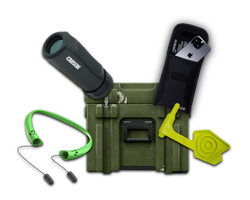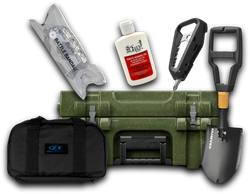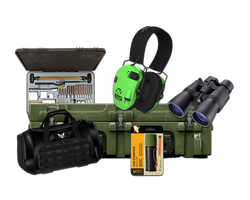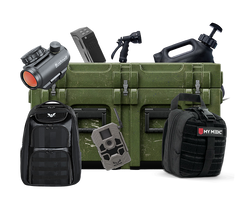How to Fold a Sleeping Bag: The Ultimate Guide for Campers and Survivalists
Table of Contents
- Introduction
- Understanding Your Sleeping Bag
- Techniques for Folding a Sleeping Bag
- Maintenance and Care for Your Sleeping Bag
- Conclusion
- FAQ
Introduction
Picture this: you've just spent a long day hiking or camping, and as the sun sets and the stars begin to twinkle in the sky, you’re ready to settle into your cozy sleeping bag. After a restful night, you wake up to a brand new day, but before you embark on your next adventure, there’s one crucial task that awaits you: packing up your sleeping bag. If you've ever struggled to fit your sleeping bag back into its carrying case, you're not alone. The art of folding and packing a sleeping bag can be a daunting task, especially when you want to ensure that it maintains its loft and insulation properties.
Understanding how to fold a sleeping bag properly isn't just about neatness; it's about preserving the functionality and longevity of your gear. With the right techniques, you can prevent damage, maintain insulation, and make packing a breeze. In this comprehensive guide, you will learn the best methods for folding and storing your sleeping bag, along with tips and tricks to ensure that you get the most out of your investment in quality gear.
By the end of this post, you will not only know how to fold a sleeping bag effectively but also understand the nuances that can impact its performance. We’ll cover various methods, the pros and cons of each, and how to choose the best technique for your specific sleeping bag type. Additionally, we'll discuss the importance of maintenance and care for your gear, ensuring that your sleeping bag remains a reliable companion on all your outdoor adventures.
Let’s dive into this essential skill that every outdoor enthusiast should master!
Understanding Your Sleeping Bag
Before we jump into the folding techniques, it's essential to understand the different types of sleeping bags and what makes each one unique. This knowledge will guide you in choosing the right folding method.
Types of Sleeping Bags
-
Down Sleeping Bags:
Made from the soft under-feathers of ducks or geese, down sleeping bags are known for their excellent insulation properties and lightweight nature. However, they can be more sensitive to compression, so it’s vital to store them properly to maintain their loft. -
Synthetic Sleeping Bags:
Constructed from synthetic fibers, these bags offer better moisture resistance and are generally easier to clean than down bags. They maintain insulation even when damp, but they can still lose their loft when compressed for long periods. -
Hybrid Sleeping Bags:
Combining both down and synthetic materials, hybrid sleeping bags aim to provide the best of both worlds. Depending on the ratio of materials used, care should be taken to follow the storage recommendations for both types.
Key Features to Look For
- Zipper Type: Some bags have a full-length zipper, while others have a shorter one. Choosing the right folding technique can depend on how the zipper is integrated into the design.
- Stuff Sack vs. Compression Sack: Some sleeping bags come with a stuff sack designed for easier packing, while others may come with a compression sack for more compact storage. Understanding how your bag is intended to be stored will influence your packing method.
Techniques for Folding a Sleeping Bag
Now that you’re familiar with the different types of sleeping bags, let’s explore the various methods for folding and packing them. Depending on your bag's material and design, some techniques may work better than others.
1. The Rolling Method
Rolling your sleeping bag is a popular technique, especially for those who are short on time or need to pack quickly. Here’s how to do it effectively:
Step-by-Step Guide
- Lay It Flat: Start by laying your sleeping bag out on a clean, flat surface where you can work comfortably.
- Zip It Up: Ensure the bag is fully zipped to prevent any air pockets that can hinder a tight roll.
- Fold in Half: Fold the sleeping bag in half lengthwise. Align the edges as closely as possible for a neat roll.
- Start Rolling: Begin rolling from the foot of the bag towards the head. Use both hands to keep the roll tight and push out any excess air as you go.
- Use Your Weight: If you’re having difficulty getting a tight roll, sit on the rolled bag or apply pressure with your knees to compress it further.
- Secure the Roll: Most sleeping bags come with straps designed for this purpose. If yours doesn’t, you can use a belt or rope to keep it in place.
Advantages and Disadvantages
- Pros: Quick and easy to do, especially when using straps.
- Cons: Frequent rolling can compress insulation, leading to loss of loft over time. It’s not ideal for long-term storage.
2. The Stuffing Method
For many modern sleeping bags, especially those designed with synthetic insulation, stuffing can be more beneficial than rolling. This method minimizes creasing and helps maintain insulation integrity.
Step-by-Step Guide
- Lay It Flat: Just as with the rolling method, start by laying your sleeping bag out flat.
- Zip It Up: Ensure the zipper is closed completely.
- Open Your Stuff Sack: If your sleeping bag has a stuff sack, open it wide and position it close to the foot of the bag.
- Start Stuffing: Begin by stuffing the foot of the sleeping bag into the stuff sack. Use your hands to push the bag down without rolling it.
- Alternate Stuffing: As you stuff, occasionally rotate the bag to ensure even distribution and prevent clumping.
- Compress as Needed: Once the bag is fully inside the stuff sack, gently compress it if necessary, but avoid over-compressing for long-term storage.
Advantages and Disadvantages
- Pros: Reduces wear on insulation, easier for long-term storage, maintains loft better than rolling.
- Cons: Can take more time to stuff than to roll, may require more space if you’re not using a compression sack.
Maintenance and Care for Your Sleeping Bag
Proper maintenance of your sleeping bag is crucial for its longevity and performance. Here are essential care tips to keep your gear in top shape:
Regular Cleaning
- Follow Manufacturer Guidelines: Always check the care label on your sleeping bag for specific washing instructions.
- Down Bags: Hand-wash in a bathtub with mild detergent and warm water. Rinse thoroughly to remove all soap residues.
- Synthetic Bags: Most can be machine washed on a gentle cycle. Use a front-loading washer if possible to avoid damage.
Drying
- Air Dry: Whenever possible, air dry your sleeping bag to avoid damage from high heat.
- Tumble Dry with Tennis Balls: If you must use a dryer, include a couple of clean tennis balls to help fluff up the insulation.
Storage Tips
- Keep It Loose: When not in use, store your sleeping bag loosely in a breathable storage sack, not in its compression sack.
- Avoid Prolonged Compression: Long periods of compression can damage the insulation, so only compress for travel purposes.
Conclusion
Understanding how to fold a sleeping bag is an essential skill for any outdoor enthusiast. Whether you choose to roll or stuff your bag, mastering the technique will help you maintain its insulation and prolong its life. Remember that proper care and maintenance are just as crucial as the folding method you select.
By applying the techniques outlined in this guide, you'll be well on your way to becoming a proficient gear organizer, prepared for any adventure. Additionally, don't forget to explore Crate Club's subscription services for high-quality tactical gear and survival tools that can enhance your outdoor experiences.
For more great gear and tools, check out the Crate Club Shop where you can find everything you need to stay prepared and equipped for your next journey.
FAQ
How often should I clean my sleeping bag?
It's recommended to clean your sleeping bag after every few trips or whenever it shows signs of dirt or odor.
Is it better to roll or stuff a sleeping bag?
It depends on the type of sleeping bag and your storage needs. Generally, stuffing is better for long-term storage, while rolling is quicker for packing.
Can I store my sleeping bag in its compression sack?
No, avoid storing your sleeping bag in its compression sack for long periods. Instead, use a breathable storage sack to maintain loft.
What should I do if my sleeping bag gets wet?
If your sleeping bag gets wet, dry it out as soon as possible to prevent mold and mildew. Air drying is the best option.
How can I maintain the loft of a down sleeping bag?
To maintain loft, avoid long-term compression and store it loosely in a breathable bag when not in use. Regularly fluff it up by shaking it out.
Mastering the art of folding a sleeping bag is just one step in your journey toward outdoor preparedness. With the right tools and knowledge, you can ensure that your gear remains in excellent condition for years to come.
Share this article



